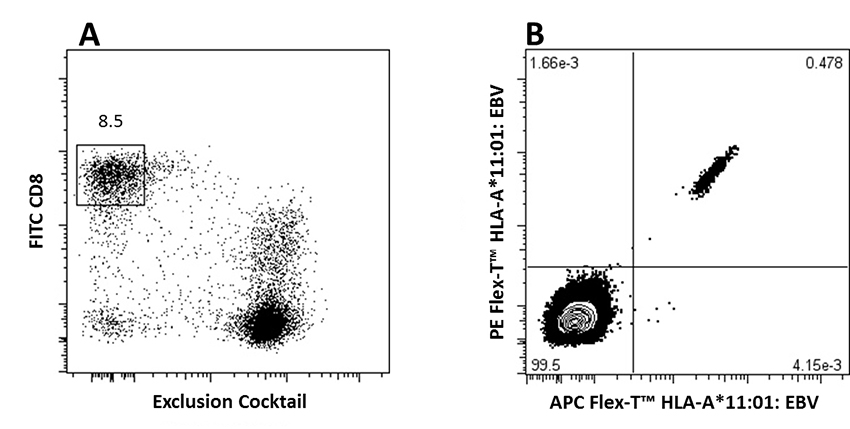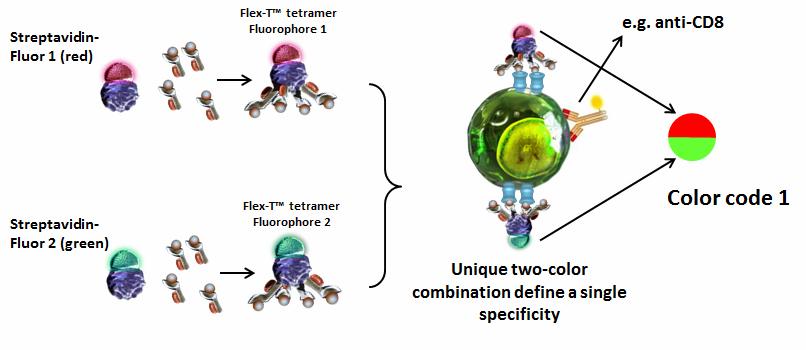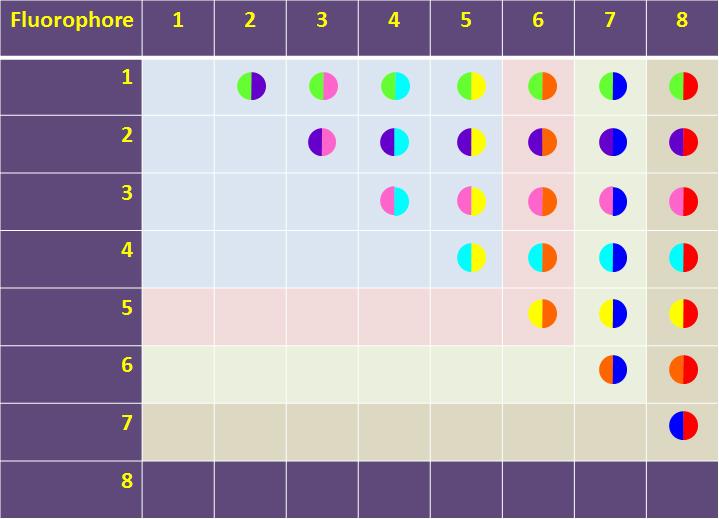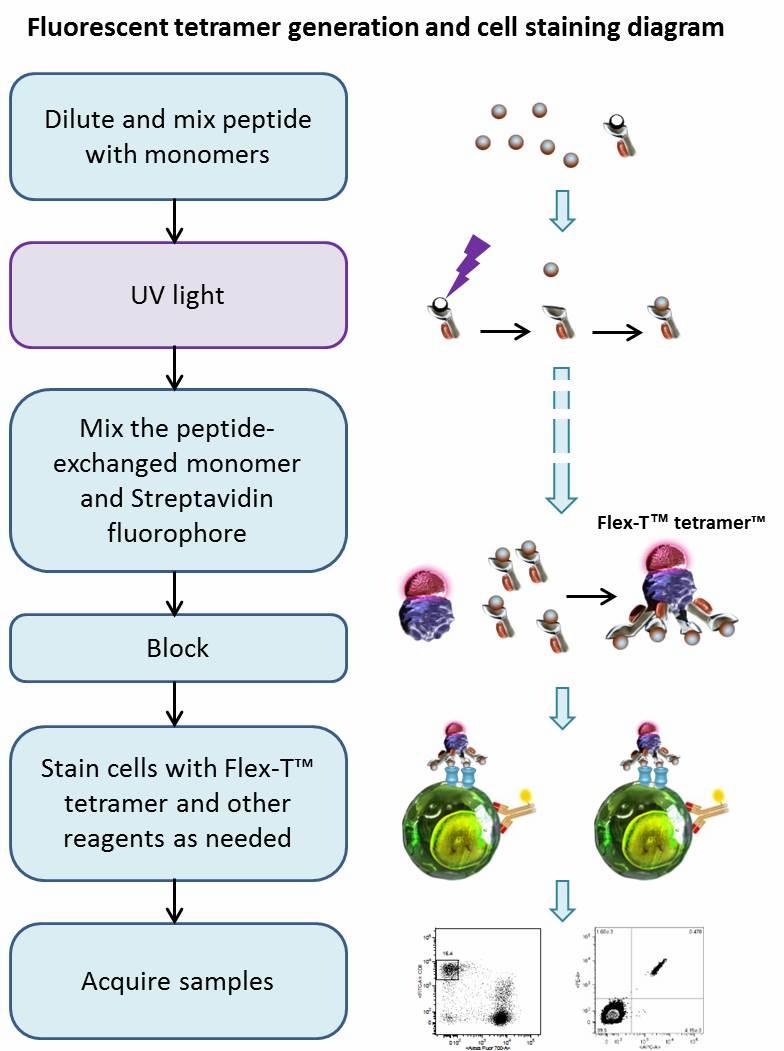What are MHC tetramers and what can you do with them?
The T-cell mediated innate immune response is defined by the interaction between antigen presenting cells and T cells, through the Major Histocompatibility Complex (MHC) and the T cell receptor (TCR). MHC molecules present a peptide to antigen-specific T cells that recognize this peptide. Soluble, monomeric MHC molecules bind very weakly to the TCR. However, by making a tetramer through a fluorescently labeled streptavidin conjugate, the complex binds to several TCRs, creating a more stable interaction and making it useful for flow cytometric detection of antigen specific T cells.
What is Flex-T™?
Flex-T™ (Flexible-Tetramers) is BioLegend’s brand name for our Soluble MHC product line. It encompasses monomers, the ultraviolet (UV) peptide exchange technology, and all associated products and applications.
Is there any advantage in buying biotinylated monomers?
Yes, the same monomer can be assembled with different Streptavidin conjugates, providing great flexibility for color choices.
Additionally, it can be stored frozen and the tetramer assembled shortly before the experiment. This increases the storage time of the reagent.
What is the peptide exchange technology and what’s the advantage of using it?
Flex-T™ MHC monomers are loaded with a peptide that can be degraded by the use of a UV light source. This allows for a peptide exchange when the UV irradiation is done in the presence of the peptide of interest (which is not UV-labile). This flexibility permits the screening of virtually any peptide of interest with enough affinity for the MHC allele that it is loaded onto.
What are the specifications of the UV source?
UV Lamp, long-wave UV source (365nm, 8 Watts, or similar). The light source should allow sample to be placed 2 – 5 cm away from the lamp.
How do I evaluate the efficiency of the peptide exchange?
Follow the protocol for HLA class I ELISA. An assay positive control can be purchased separately (Cat#280301), and it can be diluted to a high, medium, and low concentration. Signal intensity can be correlated to affinity of the peptide.
Is there any peptide length recommended?
There are no special requirements for the peptides. Peptides that naturally bind to MHC molecules will bind to Flex-T™ reagents. For class I molecules, typical length is about 8 – 10 amino acids. Class II molecules accommodate longer peptides, about 14 – 20 amino acids1.
1) Mohan JF and Unanue ER. Unconventional recognition of peptides by T cells and the implications for autoimmunity. Nat Rev Immunol. 2012 Oct;12(10):721-8.
Do I need to know the sequence of the UV-labile peptide?
The sequence of the UV-labile peptide is not needed to use the reagent. MHC molecules are not stable without a peptide, so these peptides are used just for two purposes: stabilize the MHC molecules and serve as a place holder to be substituted by the peptide of interest.
If I am still interested in “fixed” peptides, what do you recommend?
Please see the linked document titled “Peptide Sequences”. The document contains a table with commonly used peptides by allele to study antigen specific T cells.
I am interested in finding novel peptides instead, are there any resources for this?
There are a number of databases and webpages that can help, here is one of them: https://www.iedb.org/.
Is it feasible screening not just peptides, but also several specificities of antigen specific T cells in one sample?
With the traditional pre-assembled Tetramer approach, this is difficult to do, and not cost-effective. With Flex-T™ technology, as there is more flexibility to assemble the tetramers, it is easy and affordable to screen a sample for several specificities2. To facilitate this approach, a combinatorial color coding system has been developed. Please visit Flex-T™ webpage at biolegend.com/flex-t, Combinatorial Color Coding tab for a detailed description about how to do this.
2) Hadrup SR et al. Parallel detection of antigen-specific T-cell responses by multidimensional encoding of MHC multimers. Nat Methods. 2009 Jul;6(7):520-6.
Do you offer mouse monomers or tetramers?
We offer a selection of fixed peptide mouse monomers within our catalog. We also produce mouse monomers and tetramers as Custom Flex-T™ Reagents.
Do you offer custom products and services?
Yes, please contact our Custom Solution Team with your request at cst@biolegend.com, or contact your local BioLegend representative.
Are Flex-T™ products patent protected?
The Flex-T™ products and its uses are patent protected in multiple countries, in particular by patent families identified by PCT publications WO 2006/080837 and WO 2010/060439. WO 2006/080837 covers among others the UV-conditional peptide-MHC exchange. WO 2010/060439 covers among others the combinatorial coding MHC detection system.
The Flex-T™ products are sold with a limited use license for non-commercial research (Flex-T™️ Specific Limited Use License) For other uses, a license can be obtained from Sanquin. Please contact reagents@sanquin.nl for more information.


 Login / Register
Login / Register 












Follow Us